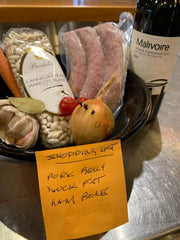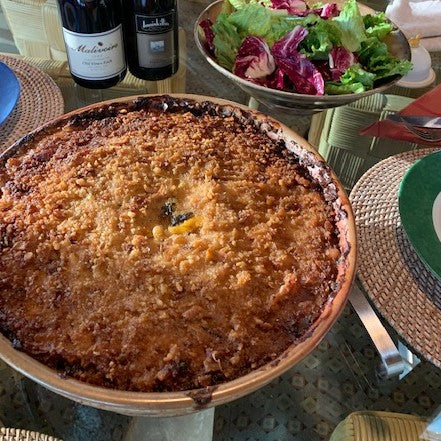Article: Martin Malivoire's Food and Wine for Comfort
Martin Malivoire's Food and Wine for Comfort
When thinking of an ideal food and wine diversion for times like these, I keep coming back to the same combination. The wine, our own 2017 Stouck Farmstead Red … and for food, the legendary cassoulet of South-West France.
Why? For a handful of reasons.
Original cassoulet is thought to have combined beans, carrots and a variety of meats that likely included pork, duck and peasant sausage. A popular legend claims it was invented in 14th century Languedoc when the villagers of Castelnaudary needed sustenance to outlast a siege. They gathered what ingredients they could find into an earthenware pot, or cassolle, and slow-cooked them into a rich bean stew. Cassoulet, then, was born of necessity to keep health and spirits high during trying times.
 Second, cassoulet became an iconic folk food largely due to its connection to the spring season. After winter, farm folk would empty their larders to come up with something for their tables. Conveniently, cassoulet was made from what could still be found in the pantry, and it was hearty, tasty and fulfilling.
Second, cassoulet became an iconic folk food largely due to its connection to the spring season. After winter, farm folk would empty their larders to come up with something for their tables. Conveniently, cassoulet was made from what could still be found in the pantry, and it was hearty, tasty and fulfilling.
Third, there is a historic Canadian connection. The Age of Discovery brought to France the importation of white beans from the New World, which largely supplanted the Mediterranean-grown fava beans originally used in cassoulet. Furthermore, French settlers arriving in North America brought traditional Old-World recipes, which they adapted with local ingredients. Classic French Canadian “feves au lard” were cassoulet-style bean strews, customized with such New World ingredients as maple syrup and molasses, perhaps very long ago. The imagination ponders…
“A fragment of pottery…made from the clay of Issel in South West France… found only shouting distance from the location of the ancient Oak Island Money Pit… a clue? That a priceless 14th century scroll, holding the original recipe for cassoulet, was spirited over the Atlantic for concealment on Oak Island, possibly by the Knights Templar?”
…but I digress.
Fourth, is the connection to us. Longtime followers of Malivoire Wine will remember when, a dozen or so years ago, we would host an annual “Cassoulet Cook-off”. A panel of chefs would square off, each set to prove to the judges that they alone could concoct the cassoulet most tantalizing with the local red wine we would supply. These were exciting, convivial occasions that I’ve often been tempted to revisit.
Finally, to devour a helping of cassoulet with the gusto deserved, requires wine of outstanding exuberance. After delicious trials in my own kitchen, I heartily recommend Stouck Farmstead Red, made exactly for this kind of meal… but more on that later.

Cassoulet comes in many styles. Recipes and ingredients vary locally and according to personal taste. One of my favourite recipes, inspired by culinary author Jeanne Strang, specialist in the cuisine of South-West France, is as follows:
Ingredients:
1 kg dried white haricot beans
Carrots
Onion with 2 cloves
2 cloves of garlic
Peppercorns
Bouquet garni
2 tablespoons goose fat
350 g of salted belly of pork with rind
350 g lean pork shoulder
2 duck quarters
700 g pork sausage
2 medium-sized onions
250 g skinned, de-seeded tomatoes
1.25 litres meat stock
Salt and pepper
Preparation:
Thoroughly immerse the beans in water and leave to soak for at least 8 hours. Remove the beans and transfer to a pot filled with fresh cold water on the stovetop. Bring gradually to a boil. Skim the surface of the boiling water after 10 minutes, add pork belly, sliced carrot, onion with cloves, garlic, peppercorns and bouquet garni. Cover and simmer, adding salt if desired, for roughly half an hour until the beans are tender.
Seal the pork shoulder with heated goose fat and cut into 2.5 cm. cubes. Add chopped onions and carrot slices and brown the meat. In a separate skillet, fry the sausage golden brown. Drain the excess fat, slice the sausage and add it to the pork and vegetables. Add the tomatoes, cover by pouring in the meat stock and stir in the chopped garlic and seasoning. Simmer gently for one hour.
Cook the duck quarters in their own fat, then remove the meat from the bone and cut into bite-size pieces. Remove the pork belly from the simmered vegetables. Trim off the rind and place it, fat side down, in a casserole. Ideally, use an earthenware cassolle. Place half of the white beans on top of the rind, dice the pork belly and layer it over, along with the other meats, then cover the meat with the remaining beans. Pour in the broth that the meat simmered in, and top off with the liquid from the bean pot, until the contents of the cassolle are nearly covered.
Cook in an oven at 150°C, adding to the liquid as it diminishes. After an hour, moisten the surface with melted goose fat, then cook for 2 additional hours.
To make traditional cassoulet requires up to three days, which is another “plus” when you’re spending time at home (as many of us are), looking for pleasant distractions.
As I mentioned, an open bottle of Stouck Farmstead Red makes the table complete. It has the right weight and generous flavour to perfectly dress a spring cassoulet meal. It’s made from Stouck Farm grapes, grown only a stone’s throw from the winery.
I hope you enjoy this recipe. If you do, and are hungry for more, I recommend looking up Jeanne Strang’s wonderful book, “Goose Fat and Garlic, Country Recipes from South-West France”.






